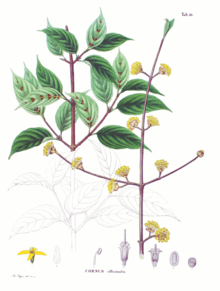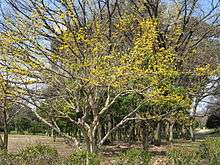Cornus officinalis
Cornus officinalis is a species of dogwood known also as Japanese cornel or Japanese cornelian cherry or Cornelian cherries, not to be confused with C. mas, which is also known as the Cornelian cherry. The correct term would be Korean cornel dogwood or Chinese cornel dogwood since the flower originated from Korea and China. These plants are not closely related to the true cherries of the genus Prunus.
| Cornus officinalis | |
|---|---|
 | |
| Scientific classification | |
| Kingdom: | Plantae |
| Clade: | Tracheophytes |
| Clade: | Angiosperms |
| Clade: | Eudicots |
| Clade: | Asterids |
| Order: | Cornales |
| Family: | Cornaceae |
| Genus: | Cornus |
| Subgenus: | Cornus subg. Cornus |
| Species: | C. officinalis |
| Binomial name | |
| Cornus officinalis | |

Description
It is a large, strongly-growing deciduous shrub with rough flaky bark. Umbels of acid yellow flowers appear in early spring before the oval leaves. The red berries, which are edible, appear later in the summer, and the leaves turn shades of red before falling in the autumn.[1]
Etymology
In Korean it is known as sansuyu (산수유), in Chinese as shān zhū yú (山茱萸) and in Japanese as sanshuyu (さんしゅゆ).
The Latin specific epithet officinalis refers to plants which have some medicinal or culinary use - in this case the edible berries.[2]
Cultivation
The plant is valued in cultivation for providing year-round interest in the garden. It is, however, quite a substantial shrub, typically growing to 8 m (26 ft) tall and broad. The cultivar 'Kintoki', with larger and more abundant flowers, has won the Royal Horticultural Society's Award of Garden Merit.[3][4]
Traditional medicine
It occurs in China, Japan and Korea where it is used as a food plant and as a medicinal plant.
Chemical constituents
The plant contains oleanolic acid and ursolic acid.[5] Ursolic acid has shown in vitro protective effects on auditory cells.[6]
Ethanolic extracts of the fruit of C. officinalis has been shown to prevent hepatic injuries associated with acetaminophen-induced liver injury-induced hepatotoxicity (in mice) by preventing or alleviating oxidative stress.[7]
The chemical constituents isolated from the fruit (Corni fructus) have protective effects on beta cells in vitro,[8][9] and may control postprandial hyperglycemia by alpha-glucosidase inhibition.[10]
Cornel iridoid glycoside, a chemical extracted from Cornus officinalis, promoted neurogenesis and angiogenesis and improved neurological function after ischemia in rats.[11]
A randomized, double-blinded, placebo-controlled study found that a Chinese herbal formula that mainly consisted of Cornus officinalis was not only effective at improving erectile function, but it was also safe for the treatment of erectile dysfunction.[12] A chemical substance isolated from Cornus officinalis also may enhance the motility of human sperm.[13]
Cell cultures of C. officinalis contain gallotannins in the forms of tri-, tetra- and pentagalloylglucoses. The main tannins are 1,2,3,6-tetragalloylglucose, 1,2,6-trigalloyl-glucose, 1,2,3,4,6-pentagalloyl-glucose and 6-digalloyl-1,2,3-trigalloyl-glucose.[14]
Nutrition
Cornelian cherry juices are rich in potassium, calcium, sodium, iron, zinc, manganese, and copper. Compared to other juices obtained from plum, pear, and apple, Cornelian cherry juice contained higher levels of dietary minerals.[15]
Gallery

trunk brush leaves 
flowers 
flowers
References
- "Cornus officinalis". www.rhs.org. Royal Horticultural Society. Retrieved 8 February 2020.
- Harrison, Lorraine (2012). RHS Latin for Gardeners. United Kingdom: Mitchell Beazley. ISBN 184533731X.
- "Cornus officinalis 'Kintoki'". www.rhs.org. Royal Horticultural Society. Retrieved 8 February 2020.
- "AGM Plants - Ornamental" (PDF). www.rhs.org. Royal Horticultural Society. July 2017. p. 107. Retrieved 8 February 2020.
- Wang R., Wang S.M., Liang S.W., Xu G.W., Weng Q.F. Zhong yao cai Zhongyaocai "Separation and determination of oleanolic acid and ursolic acid from Cornus officinalis by capillary electrophoresis". Journal of Chinese medicinal materials. 30 (8) (pp 946-950), 2007
- Yu H.-H., Hur J.-M., Seo S.-J., Moon H.-D., Kim H.-J., Park R.-K., You Y.-O., "Protective effect of ursolic acid from Cornus officinalis on the hydrogen peroxide-induced damage of HEI-OC1 auditory cells". American Journal of Chinese Medicine 37 (4) (pp 735-746), 2009
- Ha H., Lee N.-H., Seo C.-S., Lee H.-Y., Jung D.-Y., Lee J.-K., Lee J.-A., Song K.Y., Shin H.-K., Lee M.-Y., Seo Y.B., Kim H.,"Hepatoprotective and antioxidative activities of cornus officinalis against acetaminophen-induced hepatotoxicity in mice". Evidence-based Complementary and Alternative Medicine. 2012 , Article Number: 804924.
- Lin MH, Liu HK, Huang WJ, Huang CC, Wu TH, Hsu FL., "Evaluation of the potential hypoglycemic and Beta-cell protective constituents isolated from Corni fructus to tackle insulin-dependent diabetes mellitus." J Agric Food Chem. 2011 Jul 27;59(14):7743-51
- Yokozawa T, Park CH, Noh JS, Tanaka T, Cho EJ "Novel action of 7-O-galloyl-D-sedoheptulose isolated from Corni Fructus as a hypertriglyceridaemic agent". J Pharm Pharmacol. 2009 May;61(5):653-61
- Park C.H., Noh J.S., Tanaka T., Uebaba K., Cho E.J., Yokozawa T.,"The effects of corni fructus extract and its fractions against alpha-glucosidase inhibitory activities in vitro and sucrose tolerance in normal rats". American Journal of Chinese Medicine. 39 (2) (pp 367-380), 2011
- Yao RQ, Zhang L, Wang W, Li L "Cornel iridoid glycoside promotes neurogenesis and angiogenesis and improves neurological function after focal cerebral ischemia in rats." Brain Res Bull. 2009 Apr 6;79(1):69-76
- Kam S.C., Choi S.M., Jeh S.U., Lee S.H., Hwa J.S., Jung K.H., Kang C.W., Hyun J.S.,"Efficacy and safety of a herbal formula that mainly consists of Cornus officinalis for erectile dysfunction: A double-blind, placebo-controlled study". Korean Journal of Urology. 48 (7) (pp 741-747), 2007.
- Jeng H. Wu CM. Su SJ. Chang WC. "A substance isolated from Cornus officinalis enhances the motility of human sperm". American Journal of Chinese Medicine. 25(3-4):301-6, 1997.
- Gallotannin production in cell cultures of Cornus officinalis Sieb. et Zucc. Yazaki K. and Okuda T., Plant Cell Reports, 1989, vol. 8, no6, pp. 346-349, INIST:7353523, doi:10.1007/BF00716670
- Krosniak M., Gasto M., Szalkowski M., Zagrodzki P., Derwisz M., "Cornelian cherry (Cornus mas L.) juices as a source of minerals in human diet". Journal of Toxicology and Environmental Health - Part A: Current Issues. 73 (17-18) (pp 1155-1158), 2010.
External links
| Wikimedia Commons has media related to Cornus officinalis. |